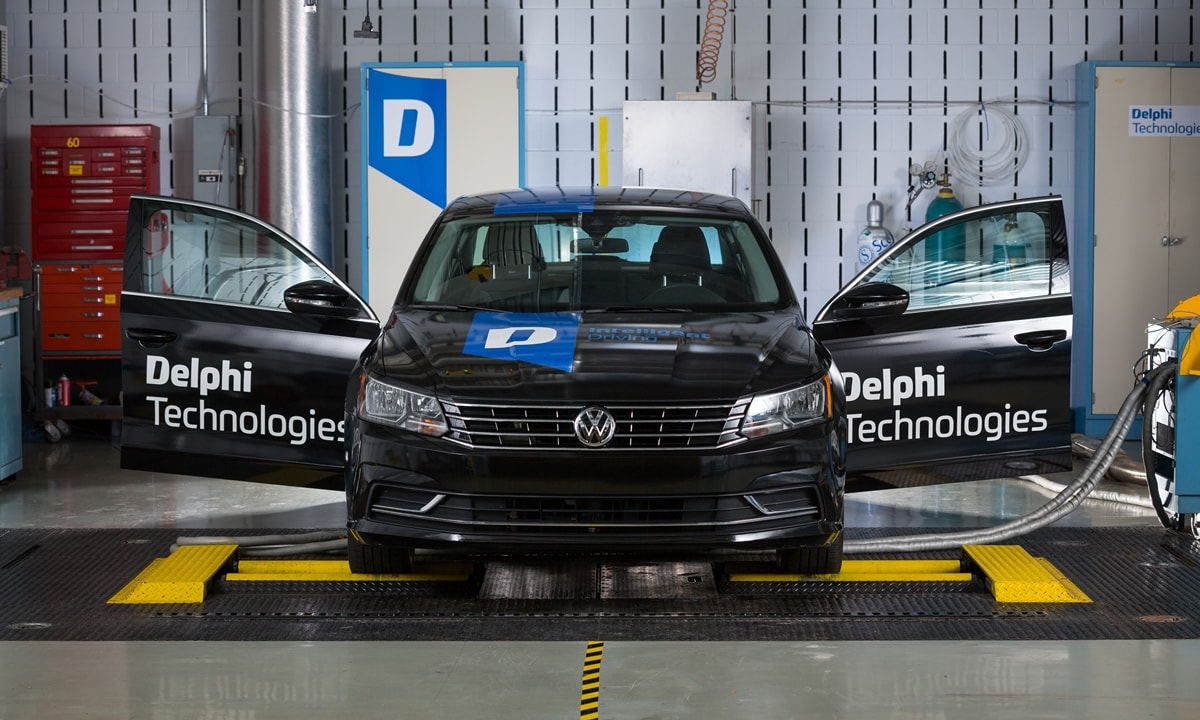
- Delphi working on V2V, cloud communication
- Improves fuel econo
- Production ready by 2022-2023
You start your car, hit the road and settle in for a long commute, or cross-country trip. You engage your car’s Adaptive Cruise to maintain safe distance behind the vehicle ahead while its Lane Keeping Assist nudges you back into your lane if you’re distracted (or drowsy) and begin drifting out of it. Many modern vehicles offer these driver-assistance capabilities (and more), which together approach “Level 2” self-driving. But they depend on a clear camera view of lane markings and radar or lidar sensing of following distance. You still must pay attention, keep your mind on the road and hands on the wheel.
Now, what if your car could know exactly where it was via GPS and would constantly communicate with the environment around it? Using cameras, radar/lidar, vehicle-to-vehicle (V2V), vehicle-to-infrastructure (V2I) and internet “Cloud” communications, it would read traffic signals and signs, detect bad weather, slippery roads, bicyclists, pedestrians, animals and other hazards ahead, offer to route you around traffic jams, accidents and construction sites, anticipate and save energy up hills, recover energy downhill, foresee stop signs and lights, slow appropriately for curves and stay within posted speed limits.
Knowing the road ahead
“What if your vehicle knew what traffic you were about to encounter, how steep the hills were on the drive ahead, or when the lights were going to turn red or green?” asks a Delphi video on the concept that the technology supplier is developing as “Intelligent Driving.” “Delphi Technologies thinks it could be worth a lot…more than 10 percent gain in fuel economy.”
“We can take all that data and apply it to our propulsion system and make it a better propulsion system that provides more range,” adds Delphi senior vice president and chief technology officer Mary Gustanski. “More range for an internal combustion engine, more range for a hybrid, more range for an electric vehicle.”
While Delphi is touting this concept primarily for saving fuel (or Hybrid/EV electricity) and increasing range by operating more energy efficiently, it could also offer obvious safety benefits. We would all appreciate more intelligent driving from others around us, but such all-informed computer-controlled “Intelligent Driving” could make our vehicles nearly as smart as the most attentive and experienced driver to help keep us out of trouble. And it proposes to do this by integrating all these inputs into a master propulsion controller that would rule (or maybe replace) not only your vehicle’s engine and transmission controllers but also, for electric and hybrid vehicles, both power inverter and battery management systems.
Onboard experience
We were recently invited to try an early prototype version of “Intelligent Driving” in a VW Passat development car (converted to a 48-volt gas/electric hybrid) on a new test track at Flint, Michigan’s Kettering University. Following a briefing by Gustanski, we drove two laps of the short course fairly aggressively without the system engaged. Accelerating up hills and through curves as we might on a hilly two-lane road, we set the bar pretty low for how much more efficiently the automated system would drive.
Then we tried it with the “intelligent” propulsion system. The engineer in the passenger seat instructed us to step on a floor-mounted red button with our left foot (a not-for-production “fail-safe” switch that, if released, would quickly disable the system should it start behaving unintelligently), engage the Adaptive Cruise steering wheel button, and step on the gas. The car accelerated normally to the posted 35-mph limit before we braked for a stop sign.
After the stop, we pushed the “Resume” button to re-engage Adaptive Cruise, then accelerated to the posted 45 mph before the system automatically slowed the car slightly for a curve, then maintained speed (using some battery power to save fuel) up a hill, slowed for another curve, then recovered electric energy downhill through regenerative braking (when the hybrid’s drive motor becomes a generator), and on through the course. In short, it controlled our speed much like most human drivers would, less aggressively and efficiently than we had.
A 16-percent boost in fuel efficiency
To prove the efficiency point, they measured the Passat’s fuel economy through all our drives that day, then compared how we journalist drivers did vs. the intelligent system. “On average for the group of journalists,” Delphi engineering manager, Advanced Vehicle Systems Keith Confer reported afterward, “the Intelligent Drive system improved fuel consumption by 16 percent over not using the system, while showing only about four percent longer time to complete the route.” And he added that our own Intelligent Driving laps used a whopping 30 percent less fuel while taking 25 seconds longer than our much more aggressive ones.
One concern about self-driving vehicles is that their propulsion systems will almost certainly be programmed to obey every traffic law, including posted speed limits however unnecessarily low they may be in some places. Meanwhile, most human drivers will continue driving according to traffic and road conditions, as they always have, almost regardless of posted limits, making computer-driven vehicles potentially dangerous obstructions in the stream of traffic moving at faster “prevailing” speeds. We doubt whether automakers will be willing (or allowed) to let autonomous vehicle occupants choose extra-legal speeds, and they might also slow more and sooner for traffic lights and curves than human drivers behind them.
But Delphi’s Intelligent Driving development, at least for now, is mostly about reducing energy consumption, which it apparently can. Gustanski says it could be ready for production by 2022 or 2023 and could be applied to all vehicles, not just those with electrified propulsion systems.







